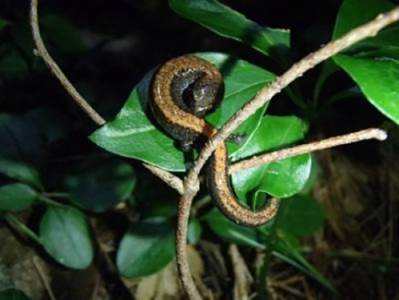环境升温致使蝾螈变小
来源:《Global Change Biology》
作者:Nicholas M. Caruso等
时间:2014-04-08

A researcher bags a red backed salamander, Plethodon cenereus, prior to swabbing it, measuring it, and releasing it. Next, researchers will study whether smaller size is a useful adaptation to climate change, or is related to population declines.
当生存环境变得越来越温暖、越来越干燥,生活在北美最好的蝾螈栖息地的野生蝾螈也逐渐变小,以便更多能量的消耗用于适应不断变化的气候。
这是发表在《全球变化生物学》的一个新研究的主要发现。研究人员检测自1957到2007年从阿帕拉契山脉采回的博物馆蝾螈标本和2011-2012年同一地点的野生蝾螈。从1980年起,蝾螈个体比十年前的平均小8%。阿巴拉契亚山脉南部和低海拔地域的变化最显着,详细的气象记录表明这些地方的气候变暖变干幅度最大。
科学家们预测,一些动物会在应对气候变化过程中变小,这项研究强力证明了预测。
“这是长期以来动物中记录下的最大、最快速的改变之一,”马里兰大学生物学副教授和研究资深作者Karen R. Lips说。“我们不确切地知道如何或为什么会发生,但我们的数据表明其与气候变化有密切的关系。”尤其这发生在蝾螈和其他两栖动物处于危机状态而部分物种即将灭绝以及其他物种数量减少的时候。
“我们不知道这是否是遗传改变或动物有足够适应新条件的弹性这一标志”,Lips说。“如果是这些动物正在调整,就给了我们希望,一些物种将能够与气候变化齐头并进。”
这项研究由马里兰大学教授Emeritus Richard Highton的工作促发,他于1957年开始收集阿巴拉契亚山脉的蝾螈。地质古山脉的潮湿森林和漫长的进化历史使阿巴拉契亚山脉成为蝾螈物种的全球热点。Highton收集成千上万的蝾螈,现在 保存在马里兰州苏特兰史密森学会的博物馆服务中心。
但Highton的记录表明,该地区的蝾螈种群数量在20世纪80年代初神秘下降。两栖动物专家Lips发现了美国中部青蛙也有类似的数量下降,并追踪发现到一个致命的真菌疾病。她决定探明是否真菌疾病导致阿巴拉契亚山蝾螈下降。
自2011夏季到2012春季,Lips和她的学生测量了包括马里兰、维吉尼亚州、西弗吉尼亚州、田纳西州和北卡罗来纳州等78个Highton采集地点的野生蝾螈DNA样本。使用相对新的技术分析保存标本的DNA,研究人员考查Highton的蝾螈是否具有疾病。
Lips发现博物馆的标本或活物实际上没有真菌病。但当她比较陈年标本和现时野生蝾螈的测量大小时,发现显著差异。
自1957到2012年之间,六个蝾螈种显著变小,只有一种稍微变大一点。研究人员发现,平均每一代比其父母一代小1%。
研究小组下一步将对变得越来越小的蝾螈种与其范围正在消失的蝾螈种进行比较研究。如果它们相匹配,研究小组将离‘为什么曾经是蝾螈天堂的地方的蝾螈数量正在下降’这个问题的答案更近一步。
这项研究由马里兰大学的史密森学会种子资助计划资助。(编译:中国科学院成都生物研究所 王芋华,王海燕)
Widespread rapid reductions in body size of adult salamanders
in response to climate change
Abstract Reduction in body size is a major response to climate change, yet evidence in globally imperiled amphibians is lacking. Shifts in average population body size could indicate either plasticity in the growth response to changing climates through changes in allocation and energetics, or through selection for decreased size where energy is limiting. We compared historic and contemporary size measurements in 15 Plethodon species from 102 populations (9450 individuals) and found that six species exhibited significant reductions in body size over 55 years. Biophysical models, accounting for actual changes in moisture and air temperature over that period, showed a 7.1–7.9% increase in metabolic expenditure at three latitudes but showed no change in annual duration of activity. Reduced size was greatest at southern latitudes in regions experiencing the greatest drying and warming. Our results are consistent with a plastic response of body size to climate change through reductions in body size as mediated through increased metabolism. These rapid reductions in body size over the past few decades have significance for the susceptibility of amphibians to environmental change, and relevance for whether adaptation can keep pace with climate change in the future.
原文链接:http://onlinelibrary.wiley.com/doi/10.1111/gcb.12550/pdf




